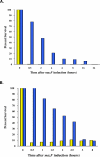Bacterial programmed cell death and multicellular behavior in bacteria
- PMID: 17069462
- PMCID: PMC1626106
- DOI: 10.1371/journal.pgen.0020135
Bacterial programmed cell death and multicellular behavior in bacteria
Abstract
Traditionally, programmed cell death (PCD) is associated with eukaryotic multicellular organisms. However, recently, PCD systems have also been observed in bacteria. Here we review recent research on two kinds of genetic programs that promote bacterial cell death. The first is mediated by mazEF, a toxin-antitoxin module found in the chromosomes of many kinds of bacteria, and mainly studied in Escherichia coli. The second program is found in Bacillus subtilis, in which the skf and sdp operons mediate the death of a subpopulation of sporulating bacterial cells. We relate these two bacterial PCD systems to the ways in which bacterial populations resemble multicellular organisms.
Conflict of interest statement
Competing interests. The authors have declared that no competing interests exist.
Figures




References
-
- Raff M. Cell suicide for beginners. Nature. 1998;396:119–122. - PubMed
-
- Hengartner MO. The biochemistry of apoptosis. Nature. 2000;407:770–776. - PubMed
-
- Daniel NN, Korsmeyer SJ. Cell death critical control points. Cell. 2004;116:205–219. - PubMed
-
- Vanvushin BF, Bakeeva LE, ZamayatninaVA, Aleksandrushkina NI. Apoptosis in plant: Specific features of plan apoptotic cells and effect of various factors and agents. Int Rev Cytol. 2004;233:135–179. - PubMed
Publication types
MeSH terms
Substances
LinkOut - more resources
Full Text Sources
Other Literature Sources
Medical
Molecular Biology Databases

